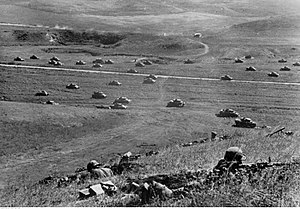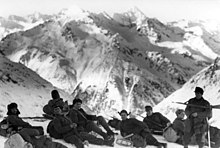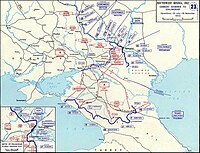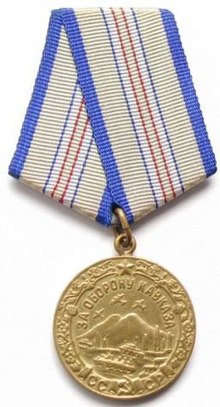
Wilhelm List was a German Generalfeldmarschall during World War II who was convicted of war crimes by a US Army tribunal after the war. List commanded the 14th Army in the invasion of Poland and the 12th Army in the invasions of France, Yugoslavia and Greece. In 1941 he commanded the German forces in Southeast Europe responsible for the occupation of Greece and Yugoslavia. In July 1942 during Case Blue, the German summer offensive in Southern Russia, he was appointed commander of Army Group A, responsible for the main thrust towards the Caucasus and Baku.

Paul Ludwig Ewald von Kleist was a German Generalfeldmarschall of the Wehrmacht during World War II. Born into the Prussian noble family von Kleist, Kleist entered the Prussian Army in 1900 and commanded a cavalry squadron during World War I. Kleist joined the Reichswehr of inter-war Germany before being discharged in 1938.
Army Group A was the name of three distinct army groups of the Heer, the ground forces of the Wehrmacht, during World War II.

Case Blue was the Wehrmacht's plan for the 1942 strategic summer offensive in southern Russia between 28 June and 24 November 1942, during World War II. The objective was to capture the oil fields of Baku, Grozny and Maikop for two purposes: to enable the Germans to re-supply their low fuel stock and also to deny their use to the Soviet Union, thereby bringing about the complete collapse of the Soviet war effort.

The Battle of Rostov (1941) took place on the Eastern Front of World War II around Rostov-on-Don and was fought between Army Group South of Nazi Germany and the Southern Front of the Soviet Union.

Operation Little Saturn was a Red Army offensive on the Eastern Front of World War II that led to battles in Don and Chir rivers region in German-occupied Soviet Union territory in 16–30 December 1942.
The 1st Panzer Army was a German tank army that was a large armoured formation of the Wehrmacht during World War II.

The 5th SS Panzer Division Wiking or SS Division Wiking was an infantry and later an armoured division among the thirty-eight Waffen-SS divisions of Nazi Germany. During World War II, the division served on the Eastern Front. It surrendered on 9 May 1945 to the American forces in Austria.
The North Caucasus Front, also translated as North Caucasian Front, was a major formation of the Red Army during the Second World War.
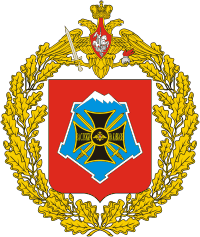
The North Caucasus Military District was a military district of the Russian Armed Forces from 1992-2010. Before 1992 it had been part of the Soviet Armed Forces since 1918. In 2010 it became the Southern Military District and lately also included the Black Sea Fleet and Caspian Flotilla.

The Battle of the Sea of Azov, also known as the Chernigovka pocket was an Axis military campaign fought between 26 September 1941 and 11 October 1941 on the northern shores of the Sea of Azov on the Eastern Front of World War II during Operation Barbarossa. It resulted in a complete Axis victory over the Red Army.

The North Caucasus Railway is a 1,520 mm broad gauge Russian railway network that links the Sea of Azov and Caspian Sea. It runs through ten federal subjects: Rostov Oblast, Krasnodar Krai, Stavropol Krai, Republic of Adygeya, Karachay–Cherkessia, North Ossetia, Ingushetia, Chechnya, Dagestan, and Kalmykia. The headquarters are the North Caucasus Railway Administration Building in Rostov-on-Don.
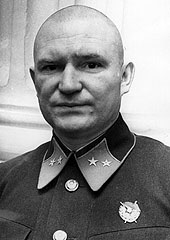
Konstantin Apollonovich Koroteyev was a Soviet Army colonel general and a Hero of the Soviet Union.
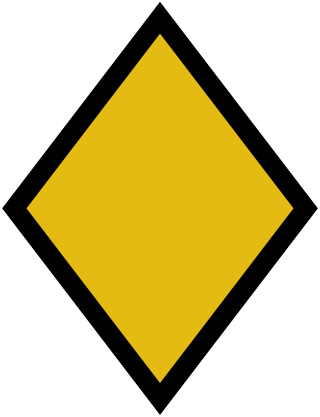
The 111th Infantry Division was a major unit of the German Wehrmacht. Formed in late 1940 in the further expansion of the German army it was committed to the campaign against Russian, and spent 3 years on the eastern front. The division was finally trapped in the Crimea and destroyed in the spring of 1944.
The 347th Rifle Division began forming in mid-September 1941, as a Red Army rifle division, in the North Caucasus Military District. It was soon assigned to the 58th Army while both it and its Army continued to form up before entering combat in November, as part of the offensive that first liberated Rostov-on-Don. During the German summer offensive in 1942 the division retreated back into the Caucasus, fighting to defend the routes to the oil fields at Baku, until the German forces began to retreat after their defeat at Stalingrad. During 1943 and early 1944 it continued to serve in the southern part of the front, taking part in the liberation of Crimea, before being transferred to the Baltic States region, serving in Latvia and Lithuania for the duration of the war, compiling a distinguished record of service along the way. In 1946 it was reformed as a rifle brigade, and its several successor formations remained part of the Red Army until 1959, when it was finally disbanded.

The 402nd Rifle Division was raised in 1941 as an infantry division of the Red Army, and served throughout the Second World War in that role. It was raised as an Azerbaijani National division in the Transcaucasus Military District and first formed part of the occupation force following the Anglo-Soviet invasion of Iran. It returned to the USSR in April, 1942, remaining in the Caucasus region until the forces of German Army Group A began its drive on the oil fields there as part of Operation Blue. In October it joined the Northern Group in the Transcaucasus Front, in the 44th Army, defending the direct route to Baku. The division took part in the counteroffensive that threw the German forces out of the Caucasus, but took heavy losses in the process. Once the German threat receded the 402nd returned to guard duties along the border with Turkey and served as a training establishment for Azeri recruits for the duration of the war.
The 414th Rifle Division was twice formed as an infantry division of the Red Army; very briefly in the winter of 1941/42, then from the spring of 1942 until after May 1945. It was officially considered a Georgian National division, having nearly all its personnel of that nationality in its second formation. After its second formation it remained in service in the Caucasus near the borders of Turkey and Iran in the 44th Army until the summer of 1942, when it was redeployed to help counter the German drive toward Grozny. As German Army Group A retreated from the Caucasus in January 1943 the division was reassigned to the 37th Army in North Caucasus Front, and during the fighting in the Taman Peninsula during the summer it served in both the 58th and 18th Armies, earning a battle honor in the process. It entered the Crimea during the Kerch–Eltigen Operation in November, and was awarded the Order of the Red Banner following the offensive that liberated that region in April and May 1944, fighting in the 11th Guards Rifle Corps of the Separate Coastal Army. After the Crimea was cleared the Coastal Army remained as a garrison and the 414th stayed there for the duration of the war. Postwar, it was relocated to Tbilisi, being renumbered as the 74th Rifle Division in 1955 and disbanded the following year.
The 417th Rifle Division was formed as an infantry division of the Red Army in the spring of 1942 and served in that role until after the end of the Great Patriotic War. Although it was formed in the Transcaucasus, unlike the 414th and 416th Rifle Divisions formed in about the same place at the same time it was never designated as a National division. After its formation it remained in service in the Caucasus under direct command of the Transcaucasus Front until the summer of 1942, when it was redeployed first to the Northern Group of Forces in that Front and then to the 9th Army. As German Army Group A retreated from the Caucasus in January, 1943 the division was reassigned to the 58th Army and a few months later to 37th Army in North Caucasus Front. In July it redeployed northward to join Southern Front, where it was assigned to the 63rd Rifle Corps in 44th Army in mid-September as the Front fought through south Ukraine, eventually reaching the land routes to the Crimea. It took part in the offensive that liberated that region in April and May, 1944, fighting in the 51st Army and winning both a battle honor and the Order of the Red Banner in the process. After the Crimea was cleared the 51st Army was moved far to the north, joining 1st Baltic Front. During operations in the Baltic states the 417th was further distinguished with the award of the Order of Suvorov. In March, 1945 it joined the Courland Group of Forces on the Baltic coast containing the German forces encircled in northwest Latvia. It ended the war there and was soon moved to the Ural Military District before being downsized to a rifle brigade. This brigade was briefly brought back to divisional strength during the Cold War.
The 176th Rifle Division was an infantry division of the Red Army, originally formed as part of the prewar buildup of forces, based on the shtat of September 13, 1939. The division completed its formation at Kryvyi Rih in the Odessa Military District and at the time of the German invasion of the Soviet Union was in the same area, assigned to the 35th Rifle Corps. Being relatively far from the frontier it escaped the early disasters and retreated mostly in good order through southern Ukraine into the autumn as part of 9th Army. It then took part in the counteroffensive against the overextended German Army Group South that liberated Rostov-na-Donu for the first time in December. When Army Group A began its summer offensive in 1942 the 176th fell back into the Caucasus region, losing much of its strength in the process, but finally helping to take up a firm defense along the Terek River and finally in front of Ordzhonikidze. As a result of this fighting the division, along with its artillery regiment, were awarded the Order of the Red Banner. After the German 6th Army was surrounded at Stalingrad the 176th advanced into the western Caucasus and entered the so-called Malaya Zemlya bridgehead south of Novorossiysk in the spring of 1943 where it helped to defeat the German Operation Neptun in April and in the autumn took part in the liberation of the city, for which it was redesignated as the 129th Guards Rifle Division.
The 223rd Rifle Division was an infantry division of the Red Army, originally formed as one of the first reserve rifle divisions following the German invasion of the USSR. This first formation had a short and disastrous combat career; after arriving at the front in Ukraine in the first days of August it was immediately encircled and destroyed in the Uman Pocket.
